| Archive: | ||
| 8079787776757473727170696867666564636261 | 8887868584838281 | |
| 6059585756555453525150494847464544434241 | 4039383736353433323130292827262524232221 | 2019181716151413121110987654321 |
| Index | ||
37% Independents, 33% Democrats, 29% Republicans
Gallupby Frank Newport and Joseph Carroll
August 17, 2007
GALLUP NEWS SERVICE
PRINCETON, NJ -- White House presidential advisor Karl Rove -- who surprised the political world by announcing his pending resignation earlier this week -- had focused since the beginning of the Bush administration on building a solid and long-lasting Republican majority. But as the Washington Post's Anne Kornblut and Michael D. Shear wrote earlier this week: "Few people -- including his Republican allies -- believe Rove succeeded in what he set as his ultimate goal: creating a long-lasting GOP majority in the country that could reverse the course set 70 years ago by President Franklin D. Roosevelt."
One sign that Rove's dream has not been realized is the evident fact that both the House and the Senate are currently controlled by Democrats. But what do we know from the perspective of the American public? A review of several key indicators helps lead to a number of important conclusions about the state of the GOP in this country as Rove prepares to leave his highly influential position within the White House.
1. Americans' identification with the Republican Party at this point is low, particularly compared to the high points in and around the 2004 presidential election, but no lower than it has been at other times in recent U.S. history.
In the second quarter of this year, 29% of Americans identified as Republicans, 37% as independents, and 33% as Democrats. These percentages are based on responses to Gallup's basic party identification question: "In politics, as of today, do you consider yourself a Republican, a Democrat, or an Independent?"
The percentage of Americans identifying as Republicans has averaged lower than 30% since the end of last year -- at 29% in the fourth quarter of 2006, 28% in the first quarter of 2007, and 29% in the second quarter of this year. The current Republican percentages are at the low point of the entire Bush presidency. Americans were most likely to identify themselves as Republicans around the 2004 presidential election, with 36% of Americans saying they were Republicans in the third quarter that year.
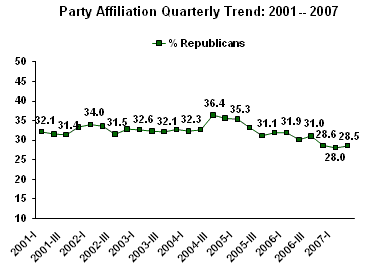
While the current 29% of Americans identifying as Republicans is low in comparison with recent years, it has been this low at other points during the past 18 years. The current Republican identification percentages, in other words, are not at historical lows. The percentage identifying as Republican was lower during the George H.W. Bush's re-election campaign in 1992 and Bill Clinton's first year in the White House in 1993 and early 1994, during Clinton's re-election campaign and first year of his second term in 1996 and 1997, and during the Clinton impeachment process in late 1998 and 1999. In fact, the lowest percentage in Gallup's recent history of those identifying themselves as Republicans was in the fourth quarter of 1998, when 27% said they were Republicans.
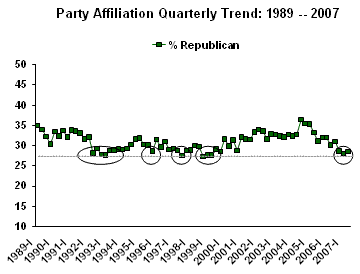
Many of those Americans who initially identify as independents will "lean" one way or the other when probed further in a follow-up question. Taking these leaners into account, Gallup finds that, in the second quarter of 2007, 41% of Americans identified as Republican, with 51% identifying as Democrat. In other words, at the moment, there is a Democratic majority in the United States based on this particular measure.
The trend on this "leaned" measure of party identification follows the same pattern as outlined above.
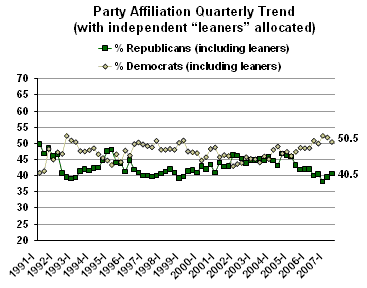
A slight majority of Americans have identified as a Democrat (or leaned in that direction) for each of the last five quarters. Despite an improved position during the time period of the 2004 election, there has not been any one quarter during the Bush administration in which a majority of Americans identified or leaned toward the Republican Party.
Past data show that the Democrats also had a majority (using the leaned party identification measure) at the time of the Clinton impeachment process in late 1998 and early 1999, at one point in 1997, at one point in 1996, and in the election year of 1992 and the first quarter of 1993.
2. The image of the Republican Party is as negative as at any point over the last 15 years.
Gallup has asked Americans to indicate if they have a favorable or unfavorable opinion of the two major political parties for more than a decade (and for many years before that using a different type of scale).
At the moment, 36% of Americans have a favorable opinion of the Republican Party, while 56% have an unfavorable opinion. Conversely, 51% have a favorable opinion of the Democratic Party, and 41% an unfavorable opinion.
Americans' overall favorability toward the Republican Party is now among the lowest measured during the Bush presidency. Since Bush took office in 2001, the percentage of Americans rating the party favorably has averaged 48%, with a high of 61% in January 2002 following the 9/11 terrorist attacks and a low of 35% at the end of last year.
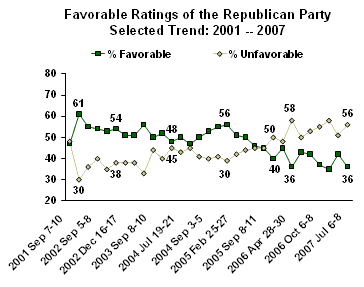
The current 36% favorable rating for the Republican Party is generally as low as it has been since 1992 (when Gallup first measured opinions of the GOP in this fashion). The GOP favorable rating was lower one time prior to the start of the Bush administration, at 31% in December 1998 during the Clinton impeachment hearings.
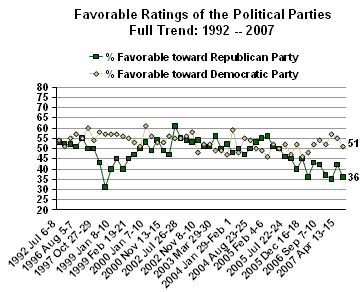
At the start of the Bush administration, the public's ratings of the two major parties were fairly similar, but Americans have consistently rated the Democratic Party more favorably than the Republican Party since April 2006. The current party rating differences are similar to what Gallup observed during the Clinton impeachment proceedings in 1998 and 1999.
3. Job approval ratings for George W. Bush, Rove's boss, are now as low as they have been since Bush took office in 2001, and are at the low range of all job approval ratings for presidents in the modern polling era.
Paul Gigot of the Wall Street Journal included this reference in his "exit interview" column in the Wall Street Journal on Monday of this week: "He [Bush] will move back up in the polls," says Mr. Rove, who interrupts my reference to Mr. Bush's 30% approval rating by saying it's heading close to "40%," and "higher than Congress."
It is true, as Rove pointed out, that Bush is "moving back up in the polls". The president's most recent job approval rating of 34% is up from his all-time low of 29% measured in early July. But 34% is still historically very low, and a far cry from the job approval ratings above 50% Bush enjoyed in most of the quarters of his first term in office.
The basic fact is that President Bush's job approval ratings are now, generally speaking, at the lowest point of his administration. Bush's approval rating average for the 26th quarter of his administration -- which ended in July -- is at 32%.
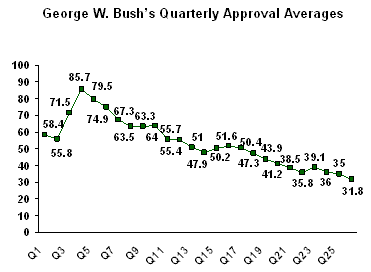
As the Gallup Poll's Jeffrey M. Jones indicated in an analysis last month, this 32% quarterly average is in the bottom 5% of all quarterly ratings for presidents going back through 1945. Only 12 quarters have been worse than this: six in the Truman administration, four in the Nixon administration, and two in the Jimmy Carter administration. (See "Bush's Latest Quarterly Approval Average Easily Surpasses Previous Low" in Related Items for a more detailed analysis of the president's quarterly job approval ratings.)
Summary
It is difficult, of course, to argue that any one person, no matter how powerful, is responsible for the fate of a major political party in the United States today. As the data show, the fate of a political party often reflects the circumstances facing the country at a given time as much as it does the actions of particular individuals. Still, Rove is generally considered to have had an unusually high degree of influence over Bush, and the Republican Party more generally, and it was clearly Rove's goal to transform the American political landscape.
The review of Gallup poll data included here, however, provides the inescapable conclusion that the state of the GOP -- as measured through the opinions of the American public -- is actually at low ebb. Fewer people identify themselves as Republicans than at any other point in the Bush administration (although not lower than at other points in the 1990s), the image of the Republican Party is at a lower point than at any other time during the last 15 years, and Rove's boss -- President Bush -- has job approval ratings that are in the bottom 5% of all presidents since the end of World War II.
Much of the reason behind these findings may lay with the unpopular Iraq war -- not an issue over which Rove necessarily had much control. Both Bush and Rove have argued that it will take years if not decades for the American public to recognize the positive impact of the situation in Iraq, and that history will look back favorably on this period of time. Plus, it is possible that the GOP may pick up strength by next year and that the White House and one or both houses of Congress may revert to Republican control -- perhaps vindicating Rove's political strategy.
But at the moment -- as Rove prepares to leave Washington and head back to Texas -- the data suggest that he is far from his goal of helping create a strong, healthy, and dominant Republican Party.
Survey Methods
Results are based on telephone interviews with approximately 1,000 national adults, aged 18 and older, conducted across various surveys in recent years. For results based on the total sample of national adults, one can say with 95% confidence that the maximum margin of sampling error is ±3 percentage points. In addition to sampling error, question wording and practical difficulties in conducting surveys can introduce error or bias into the findings of public opinion polls.
